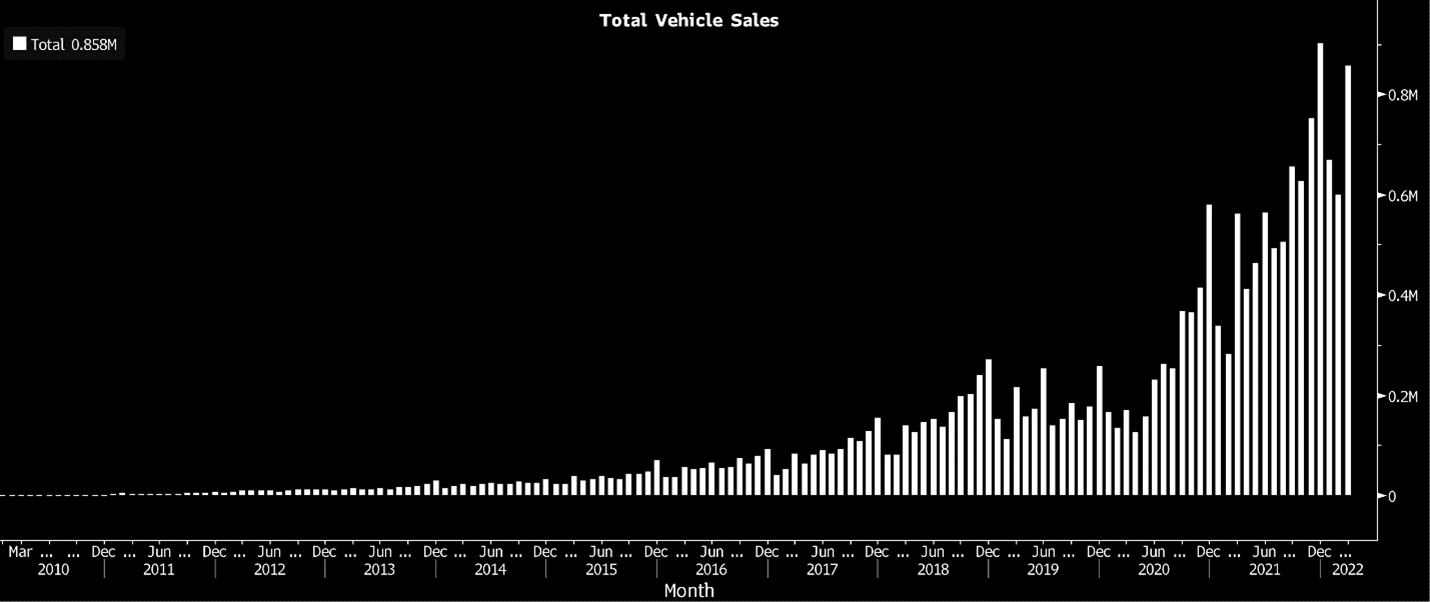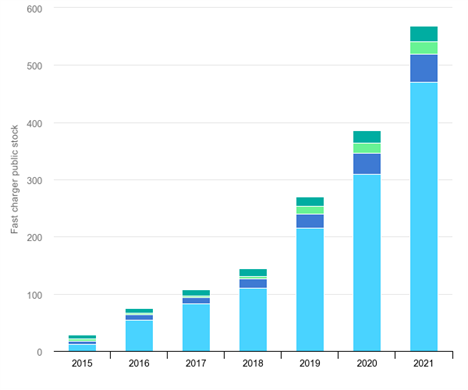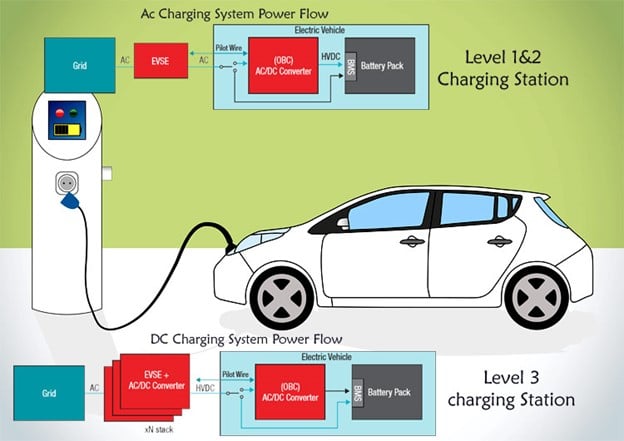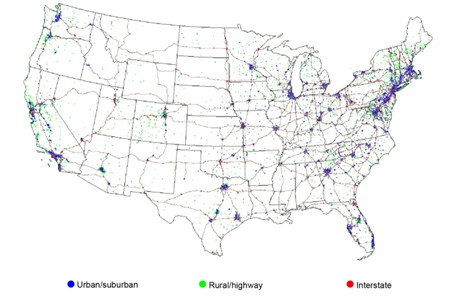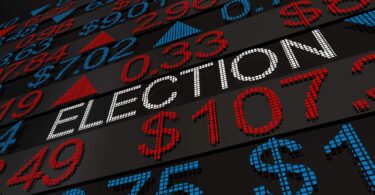- Through the first three months of the year, more than 2.1 million electric cars were sold worldwide — up an astounding 80% year-over-year.
- The International Energy Agency said that the number of EV chargers globally must increase 12X by 2030.
- The future of the EV charging landscape will be a mix of mostly L2 chargers throughout urban areas and some DC fast-chargers on interstate highways.
A lot of industries are cooling off right now thanks to runaway inflation, soaring interest rates, and decelerating consumer spending. Amid this global economic slowdown, electric car adoption is on the rise. And the EV Revolution is powering full-steam ahead.
With gas prices at the pump ticking above $5 a gallon, consumers are understandably more interested in going electric. And EV sales have followed suit.
Through the first three months of the year, more than 2.1 million electric cars were sold worldwide. That’s up an astounding 80% year-over-year.
And we think the red-hot EV industry is only going to get hotter.
Gas prices project to remain high. But EV battery metal prices have been rapidly declining after an early 2022 spike. That’s further closing the gap between gas-powered and electric car prices. And China — home to 60% of the world’s EV battery manufacturing — is reopening after repeated COVID-19 lockdowns. This is enabling much more robust global EV production through the remainder of the year. Further, the Chinese government is extending EV tax breaks. And the leaders of the G-7 countries just formed a committee called the “Climate Club.” It’s dedicated to spearheading massive EV adoption by 2030.
The proverbial stars have aligned for the EV industry to grow faster than ever before over the next few months. As that happens, we fully expect electric car stocks to power through any recession that may be on the way.
You can play this coming EV stock breakout in a lot of ways. But there’s few better options than with EV charging stocks. Here’s why.
The Case for EV Charging Stocks
Let me ask you a simple question: What good is a car without a gas station?
Not much good at all. Without fuel, a car is pretty much a paper weight on wheels. Without gas stations, our cars do us no good.
By that same token, what good is an electric car without a charging station?
An EV runs on an electric charge. If that charge runs out and there’s nowhere to refuel, then the car is useless.
No charging stations, no usable EVs.
Now, we’ve all known about the electric car megatrend for a while now. Over the next 10 years, everyone buys a Tesla (Nasdaq:TSLA), Lucid (Nasdaq:LCID), or some other electric car. But what happens when they’re traveling, and there’s nowhere to charge it?
Indeed, the electric car megatrend won’t materialize unless an equally large growth spurt happens in EV charging infrastructure.
That’s why, in its recently released 2022 EV Market Outlook report, the International Energy Agency said that the number of EV chargers globally must increase 12X by 2030. And that’s just enough for companies and governments to reach the low end of their targets for 30% of new car sales to be electric by then.
In other words, the EV market will grow by around 3X to 4X over the next decade. But the EV charging market will grow by 12X over that same stretch.
So, if you want to play the EV Revolution for truly enormous gains, forget about electric car makers like Tesla. Buy picks-and-shovels suppliers like EV charging stocks.
Lucky for you, we have the top pick in the space.
Gaining an “Edge” in Electric Car Charging Stocks
Considering the above, you’re probably thinking that it’s time to rush out there and buy some EV charging stocks, right?
Not so fast.
There are lots of EV charging companies out there today. Not all will make it. Indeed, only a handful will make it big. Most will fail. So, it’s not time to buy all EV stocks. Rather, it’s time to buy the best of them.
To know which are “the best,” let’s first understand EV charging technology.
That analysis starts with the fundamental question: How does electricity work?
In short, we generate electricity at a power source, like a coal-fired power plant or a solar farm. Then we promote the flow of electrons (the charged particles that carry electric power) outward from that source via wires. This flow of electrons is called a “current.”
That current can take two forms: alternating current (AC) or direct current (DC). DC is a direct constant flow of electrons through the wire. It results in heavy power delivery but also in significant drain on the grid. AC is an oscillating flow of electrons that results in lower power delivery but minimal stress on the grid.
Since the grid has always been load-constrained, we decided long ago to build it on AC. But since an alternating current physically hinders the ability to store energy, today’s batteries can only store power as DC.
That’s why most electronics devices, like laptops, come with power cords that have big boxes in the middle of them. Those boxes are AC/DC converters. They transform the AC power from the grid to DC power that can be stored in your laptop.
EV charging works in much the same way.
The chargers plug into the grid, which provides AC power. That power is then pumped into the electric car. On board every EV, there’s an AC/DC converter that turns AC power into usable DC power. And that is then stored in the car’s battery.
How to Pick the Best EV Charging Stocks
Understanding how EV charging works isn’t all you need to know to pick the best EV charging stocks. You also need to know the different types of EV chargers out there. Then you can pick the companies that make the most useful, highest-quality chargers.
There are two classifications of AC electric car chargers — L1 and L2.
L1 chargers are the most basic out there. They’re really slow but really cheap. They’ll give you about three to five miles of range per hour of charging. Given that they’re low-cost, low-performance in nature, L1 chargers are common as residential solutions. But they’re very rarely used beyond the home.
L2 chargers are a big step up from L1s. They’re much faster but also much more expensive. They’ll give you around 30 miles of range per hour of charging. These L2s constitute the majority of chargers on the road today.
There are also DC fast chargers. These are fundamentally distinct from AC chargers. They have built-in AC/DC converters that transform grid energy into DC power within the actual charger itself. What this enables, then, is for the charger to pump DC power directly into an EV battery. This completely bypasses the AC/DC converter in the car and results in a far more powerful charge.
These chargers are really, really fast — and really, really expensive. As a result, they can give you over 100 miles of range per hour of charging. But there aren’t many of them on the roads these days — just a few thousand across the whole U.S.
Considering this context, it’s important to understand that the future of the EV charging landscape will be a mix of mostly L2 chargers throughout urban areas and some DC fast-chargers on interstate highways.
That’s because L2 chargers are good enough. The enormous shift from gas stations to charging ports will be accompanied by a huge shift in where we “refuel.”
Since EV chargers are tiny and can be built anywhere there’s an electric connection, the days of dedicated gas stations are over. You won’t see EV charging stations replace gas stations. You’ll see gas stations become extinct. EV charging ports will pop up everywhere — your gym, grocery store, and local mall parking lot.
In the EV Charging Revolution, you’ll charge your electric car everywhere you go. So long as you aren’t traveling hundreds of miles, L2 chargers will do the job just fine. That’s because you’ll be charging as you shop or work out.
For those long road trips… well, that’s where DC fast chargers will be super useful.
Not to mention that charging does actually cost money. Right now, it costs about $2 per 30 minutes of L2 charging in a public lot.
To that end, the future of EV charging is super clear. Millions of L2 chargers will pop up across every parking lot in urban and suburban areas. DC fast chargers will replace gas stations on interstate highways, and consumers will be paying for all that charge.
That’s the future.
So, which EV stocks should you be buying right now to play that future?
The Final Word on the Electric Car Revolution
We don’t just listen to management teams and read investor decks to answer those questions.
Nope. Instead, we turn to Innovation Investor, where we leverage a team of experts — from software engineers and data scientists to seasoned traders and economists — to fully understand technological megatrends at their most fundamental level. Here, we break down every company’s underlying technology at their most elementary levels to assess validity and capability. And we look to see if they have the potential to change the world.
We do this with every company across every industry and for every technological breakthrough. The end result: We identify early stage hypergrowth tech stocks set for enormous long-term returns.
And it’s in the EV industry where we’ve found one stock that’s developed astoundingly superior, unique technology. That tech should enable it to become a dominant supplier for the whole EV industry.
The best part? As you may know, Apple (Nasdaq:AAPL) is on the cusp of launching its own self-driving electric car. And the company we’ve identified may have a secret partnership in the works with Apple.
As such, this stock is a potential 40X investment opportunity from current levels.
After all, it could be the key company behind Apple’s next big product launch.
Originally published on InvestorPlace.com
On the date of publication, Luke Lango did not have (either directly or indirectly) any positions in the securities mentioned in this article.

